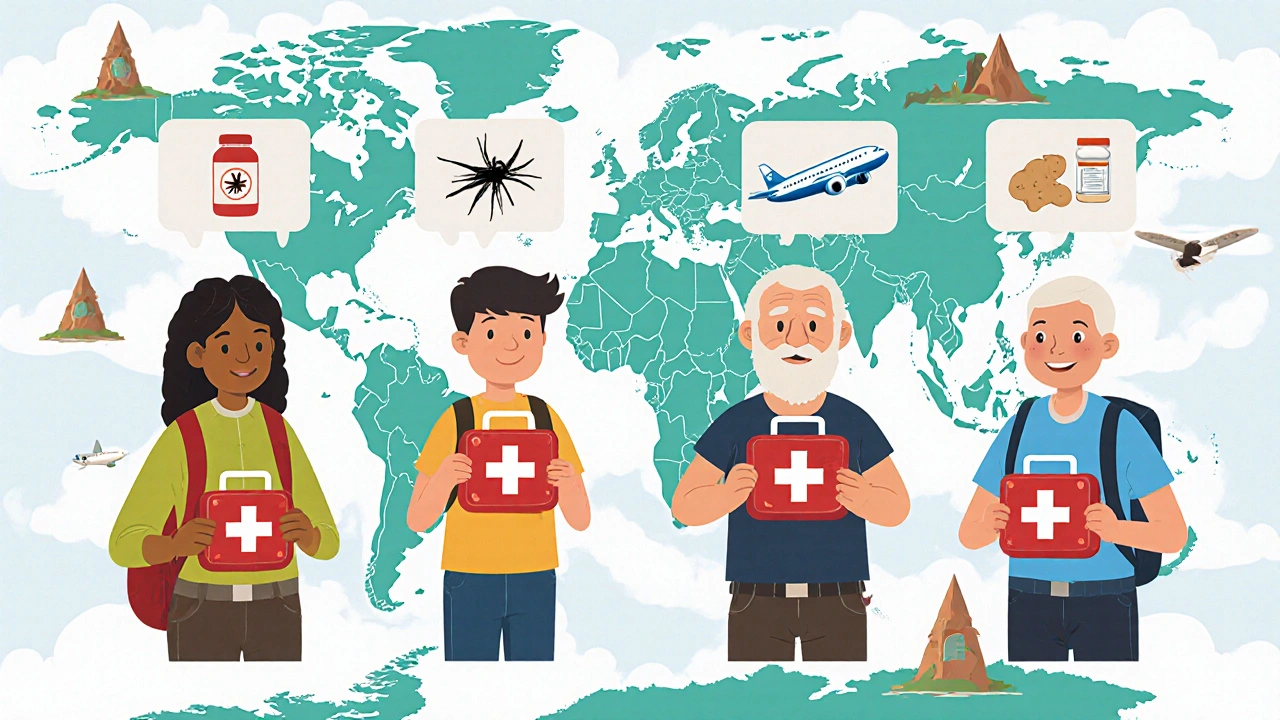Why You Need a Travel Medication Kit
Getting sick while traveling isn’t just annoying-it can ruin your trip. A stomach bug in Bali, a blister on a hike in the Alps, or an allergic reaction in a foreign city can turn a dream vacation into a nightmare. The good news? Most common travel health issues are easy to manage if you’re prepared. A well-packed travel medication kit lets you handle minor problems without hunting for pharmacies, paying high prices, or waiting in unfamiliar clinics.
According to Cleveland Clinic, you don’t need to pack your whole medicine cabinet. You just need the essentials for the most likely issues: diarrhea, pain, allergies, cuts, and motion sickness. The goal isn’t to replace a doctor-it’s to keep you moving.
What to Include: The Core Items
Every travel medication kit should have these five categories of items, no matter where you’re going.
- Pain and fever relief: Ibuprofen (200-400mg tablets) or acetaminophen (500mg tablets). Pack at least 10 tablets of each. These cover headaches, muscle aches, toothaches, and fevers. Avoid mixing them unless you know how they interact.
- Diarrhea treatment: Loperamide (Imodium, 2mg tablets) for quick relief. Add a 3-day course of antibiotics like ciprofloxacin or azithromycin-only if prescribed by your doctor. Never take antibiotics without a diagnosis. Pair it with oral rehydration salts (WHO-formulated packets). Five packets are enough for most trips.
- Allergy and insect bite relief: Loratadine (10mg) or cetirizine (10mg) tablets for runny nose, hives, or swelling. Add a 15g tube of 1% hydrocortisone cream for itchy rashes, bug bites, or mild eczema flare-ups.
- Wound care: A small pack of adhesive bandages (various sizes), 4 gauze pads (4x4 inches), medical tape, antiseptic cleaner (chlorhexidine or povidone-iodine), and antibacterial ointment (bacitracin or neomycin). These handle scrapes, cuts, and blisters.
- Stomach upset: Antacids like calcium carbonate (500mg) or famotidine (10mg). Pack 7 tablets. These help with heartburn, indigestion, or overeating on vacation.
Destination-Specific Add-Ons
Your kit isn’t one-size-fits-all. Where you’re going changes what you need.
- Hot or tropical countries: Add water purification tablets (iodine or chlorine dioxide). Tap water might be unsafe. Also, bring extra rehydration salts-dehydration hits fast in heat.
- Camping or hiking: Blister pads (like Compeed), tweezers (for splinters or ticks), and a small roll of duct tape (for emergency blister wraps). Keep tweezers in checked luggage if flying-TSA bans them in carry-ons.
- High-altitude destinations: If you’re going above 2,500 meters (8,200 ft), ask your doctor about acetazolamide (125-250mg). It helps prevent altitude sickness. Don’t self-prescribe.
- Areas with lots of bugs: Use insect repellent with 20-30% DEET. A 1oz bottle lasts a week. Avoid scented lotions or perfumes-they attract mosquitoes.
- Long flights: Motion sickness pills (dimenhydrinate or meclizine). Take one 30-60 minutes before takeoff. Also, pack a small bottle of ginger capsules-some travelers swear by them.

Prescription Medications: Don’t Skip This
If you take regular meds-blood pressure pills, insulin, antidepressants, birth control-pack more than you think you’ll need.
Travel delays happen. Your flight gets canceled. Your luggage gets lost. That’s why you need at least a 20% extra supply. Split your meds: half in your carry-on, half in your checked bag. If one goes missing, you’re not stranded.
Keep all prescriptions in their original bottles with your name on them. Bring a printed list with:
- Generic drug names (not brand names-those change by country)
- Dosage and frequency
- Reason for use (e.g., “for hypertension”)
For insulin, diabetes, or injectables, get a doctor’s letter explaining why you need needles and syringes. Some countries, like Japan and the UAE, have strict rules. Without a letter, you could be turned away at customs.
How to Pack It Right
Organizing your kit matters as much as what’s inside.
- Use a small, waterproof plastic box or zip-top bag. Clear plastic lets you see what’s inside without opening it.
- Keep pills in original containers. If you need to transfer them, label each with the drug name, dose, and expiration date.
- Store meds away from heat and sunlight. Don’t leave them in a hot car or by the pool. Insulin, thyroid meds, and some antibiotics break down above 30°C (86°F).
- Put liquids in a separate zip-lock bag to avoid leaks. Use travel-sized containers (under 100ml) for carry-ons.
- Keep a small contact card with your emergency info: your doctor’s phone, local hospital addresses, your hotel, and your country’s embassy.

Special Cases: Kids, Seniors, and Chronic Conditions
One-size-fits-all doesn’t work for everyone.
- Traveling with kids: Never give adult meds to children under 12. Use pediatric formulations. Pack infant acetaminophen or ibuprofen drops if needed. Include a digital thermometer and saline nasal drops for stuffy noses.
- Seniors: If you take multiple meds, use a pill organizer labeled by day and time. Bring extra copies of prescriptions-pharmacies abroad may not recognize your local brand names.
- Diabetics: Carry your doctor’s letter, insulin, glucose tablets, and a glucagon emergency kit. Keep insulin cool but not frozen. Bring a backup glucose meter if possible.
- Asthma or allergies: Always carry your inhaler or EpiPen in your carry-on. Bring a spare. Know the local emergency number for your destination.
What NOT to Pack
Some things seem helpful but can cause problems.
- Unused antibiotics: Never take leftover antibiotics from past illnesses. They may be expired, wrong for the infection, or illegal in some countries.
- Large bottles of liquid meds: Over 100ml can’t go in carry-ons. Use travel sizes or ask your pharmacy for smaller containers.
- Unlabeled pills: Don’t dump pills into random containers. Customs agents and pharmacists need to identify them.
- Medications banned in your destination: Pseudoephedrine (in many cold meds) is illegal in Japan. Codeine is restricted in the UAE. Check your destination’s rules before you go.
Before You Leave: Final Checks
A week before your trip, do this:
- Review your list with your doctor. Get vaccines if needed (typhoid, hepatitis A, etc.).
- Fill all prescriptions. Ask for generic names on the labels.
- Check expiration dates. Toss anything old.
- Test your waterproof container. Fill it with water and shake it. No leaks?
- Make a digital copy of your med list and email it to a trusted person.
Traveling with a medication kit isn’t about being paranoid. It’s about being smart. The world is full of unexpected bugs, bad food, and long flights. With the right supplies, you’ll handle it all without panic-or a costly clinic visit.
Can I bring prescription meds in my carry-on?
Yes, always. Keep all prescription medications in your carry-on. Never pack them in checked luggage. Airlines and customs can lose bags, and you might need your meds during the flight or upon arrival. Keep them in original bottles with your name on them, and bring a printed list of your meds and dosages.
What if I run out of my medication while traveling?
If you run out, go to a local pharmacy with your prescription list and doctor’s letter. Show them the generic name of your drug. Many countries can fill prescriptions for common medications like blood pressure or diabetes pills. Avoid buying meds from street vendors or unlicensed clinics. If you’re unsure, contact your country’s embassy for help finding a reputable pharmacy.
Are over-the-counter meds safe to buy abroad?
Sometimes, but not always. Drug names, dosages, and ingredients vary by country. A pill labeled "ibuprofen" in Thailand might have a different strength or contain additives you’re allergic to. If you’re unsure, stick to what you packed. If you must buy locally, choose large, reputable pharmacies (like Watsons or CVS-style stores) and ask for the generic name.
Can I bring liquid medications on a plane?
Yes, but there are limits. Liquid medications over 100ml are allowed in carry-ons if they’re medically necessary. You must declare them at security. Keep them in a clear bag with your prescription or doctor’s note. TSA and international airport security usually allow these exemptions, but having documentation makes the process smoother.
What should I do if I have a severe reaction while traveling?
If you have trouble breathing, swelling of the face or throat, chest pain, or sudden confusion, seek emergency help immediately. Call local emergency services or go to the nearest hospital. Do not rely on your travel kit for severe reactions. Your kit is for minor issues. Always know the local emergency number and your country’s embassy address before you leave.







13 Comments
I packed my kit last week and forgot the rehydration salts-big mistake. Ended up with a 36-hour stomach bug in Lisbon and had to pay €45 for a tiny bottle of electrolytes at a tourist trap pharmacy. Never again. Just throw in five packets. Seriously.
Look, I get it-preparation is key. But let’s be real: 90% of people who read this will still bring their entire medicine cabinet in a duffel bag, then wonder why their carry-on weighs 18 pounds. The real win here isn’t the loperamide-it’s the mental shift from ‘I need to be ready for everything’ to ‘I need to be ready for the likely stuff.’ That’s the difference between a traveler and a hoarder.
Why are we even talking about this? I’ve been to 17 countries and never once used a travel med kit. I just go to the local pharmacy, point at the pill, and say ‘this one.’ Half the time they don’t even speak English. Works fine. Also, your ‘essential’ list is basically a Walmart ad. Who even uses hydrocortisone cream anymore? I just scratch until it bleeds.
Great guide! I’d add one more thing: if you’re on birth control, bring extra pills-even if you’re only going for two weeks. I once had my bag stolen in Bangkok, and the local pharmacy didn’t carry the exact brand I used. They gave me something that made me feel like I’d swallowed a wasp. Also, always check if your meds are controlled substances abroad-I learned that the hard way in Dubai with my gabapentin. Never again.
Wow. So much effort. And for what? To avoid a 10-minute trip to a pharmacy? You’re not a soldier on a mission. You’re on vacation. If you get sick, you get sick. The world won’t end. Also, ‘never take antibiotics without a diagnosis’? That’s not advice-that’s a paragraph from a medical textbook. Who even reads this?
This is so helpful-I’m taking my mom to Bali next month and she’s terrified of getting sick. I’m printing this out and taping it to her suitcase. Also, the part about splitting meds between carry-on and checked bag? Genius. My cousin lost her insulin in luggage last year and spent three days in a Bangkok hospital. Don’t let that be you.
Love this. I used to think I was over-prepared until I got food poisoning in Vietnam and had my entire kit right there-no panic, no language barrier, no overpriced clinic. I even had ginger capsules for nausea. Best $12 I ever spent. Travel smart, not hard. You’ll thank yourself when you’re sipping coconut water on a beach instead of vomiting in a hotel bathroom.
Excellent breakdown. I would only add that for diabetic travelers, always carry a backup glucose meter, and if possible, a glucometer with a USB port to sync data. Some countries require documentation for insulin pumps, not just needles. Also, avoid storing insulin in a hotel room with no AC-heat degrades it faster than you think. I learned this in Thailand during a 42°C heatwave.
This is the most ridiculous over-preparation I’ve ever seen. You’re telling people to carry antibiotics like they’re going to war? And you think a 1oz bottle of DEET lasts a week? Try a 20-minute walk in Bali. Also, ‘don’t buy meds abroad’? That’s not advice, that’s colonialism wrapped in a ziplock bag. People in developing countries have been treating themselves for centuries without your checklist.
Appreciate the effort here. I’m a nurse and I’ve seen too many people panic because they didn’t bring anything. The part about keeping meds in original bottles? Huge. I had a guy in Bali try to buy ‘that blue pill’ for his heart and ended up with a sedative meant for dogs. Don’t be that guy. Also, the doctor’s letter for insulin? Non-negotiable. I’ve had patients detained over that. Just do it.
I once lost my entire med kit in a taxi in Mexico City. I had my EpiPen, my thyroid med, my anxiety pills-all gone. I cried in a 7-Eleven. I had to walk three miles to a clinic with a note scribbled on a napkin. I’m not exaggerating. This guide saved me. I’ve got two copies now. One in my wallet. One taped to my bathroom mirror. Don’t wait until you’re stranded to care.
Why are Americans so scared of getting sick? We have the best healthcare in the world. You don’t need a damn kit. Just buy a plane ticket and trust the system. Or better yet, stay home. You’ll live longer.
Typo in the title: ‘medication’ is spelled right, but you wrote ‘medications’ in the F.A.Q. section. Also, you said ‘ciprofloxacin or azithromycin’-but didn’t mention that azithromycin is often used for traveler’s diarrhea in Southeast Asia because of resistance patterns. And why no mention of probiotics? Lactobacillus strains help prevent diarrhea. You missed the boat.